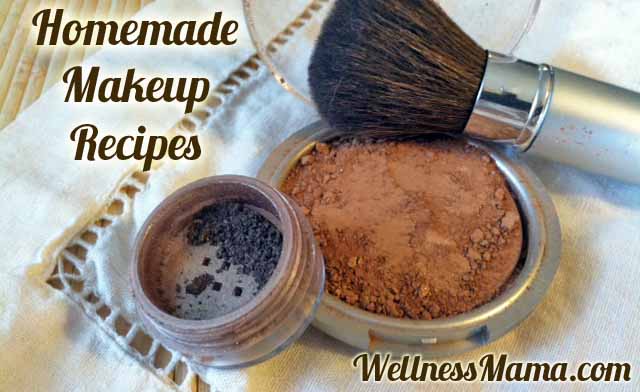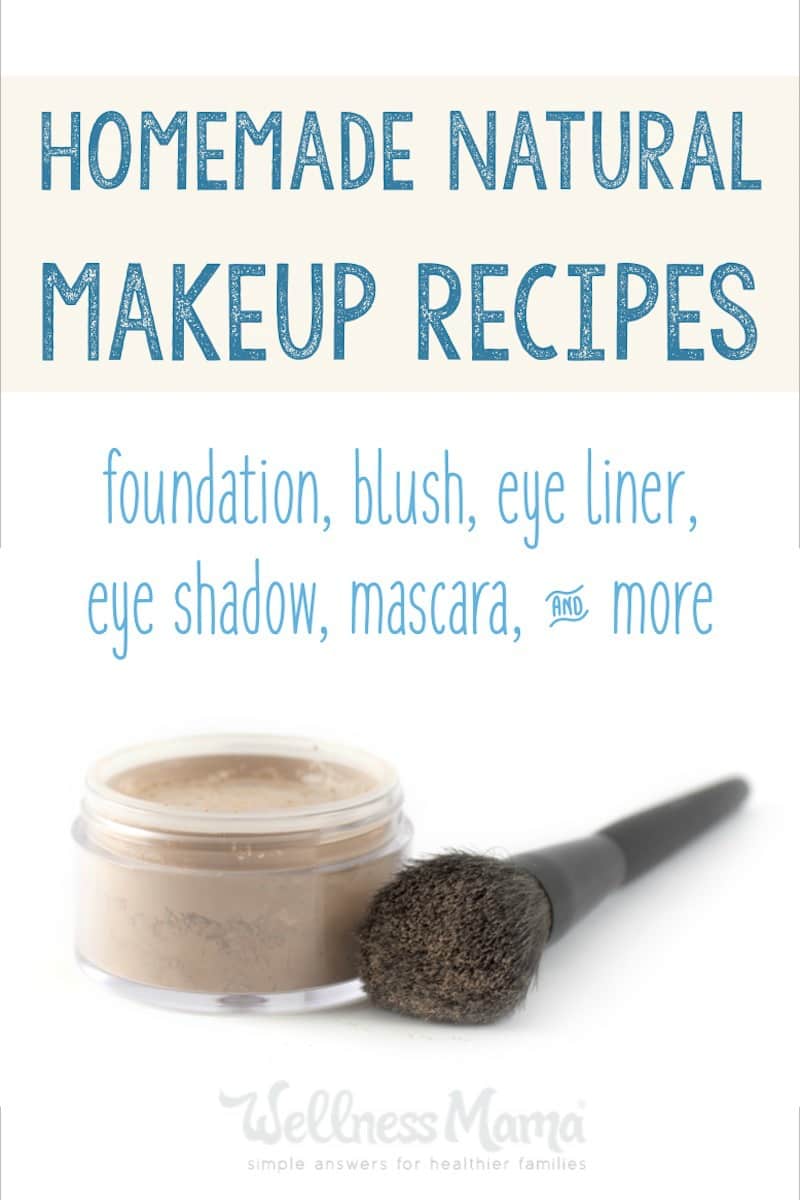
I get a lot of questions about natural makeup options, and this was definitely one of the tougher things for me to find natural alternatives for. In college, I practically collected makeup, and had endless tubes, compacts, and brushes that never even got half used.
Natural Makeup
While there are some good natural alternatives that you can buy (see list below), the cheapest, easiest, and most natural way is to just make your own, and you might have all of the ingredients in your kitchen already!
Natural Skin Care
What you do to your skin before you use makeup is just as important as the makeup you use, and there are some great natural options for skincare.
I absolutely love the oil cleansing method, which leaves the skin very soft and smooth by using natural oils to balance the skin. I typically use the oil cleansing method at night and wash my face with raw honey if needed in the morning. You can also use a natural sugar scrub (equal parts sugar and natural oil) or natural microdermabrasion (baking soda) to make the skin look younger.
With proper skincare, the skin will be naturally healthy, and you won’t even need to wear makeup most of the time. Most days, I skip the makeup altogether, but when I do wear it, these are the recipes I use:
Natural Foundation
Homemade Option: At the recommendation of a friend who had used cocoa powder for natural bronzer, I started experimenting with natural foundation options and came up with a recipe similar to mineral makeup.
I start with a base of arrowroot powder and zinc oxide (you can also use cornstarch, but arrowroot works better) and then slowly add in cocoa powder and finely ground cinnamon powder until you get a shade close to your skin tone. You can then store it in a jar or old powder container and use a brush to apply. It took me a few tries of mixing to get the color correct for my skin tone, but most days, a quick brush of this is all I need. I later discovered that adding gold mica powder gave it an even smoother texture and made the skin radiant.
Ingredients:
- 2 tablespoons zinc oxide (Can use arrowroot powder instead if desired, but it will not offer quite as much coverage)
- 1 tablespoon arrowroot powder (optional)
- 1 teaspoon gold mica dust
- 1/2 – 1 tsp of desired natural clay powder (optional) I used a pinch of White cosmetic clay, Fuller’s Earth Clay, and French green clay
- up to 1 teaspoon finely ground cocoa powder to get desired color
- Optional: 1 teaspoon of translucent mica powder can help for really oily skin
Instructions:
- Mix all ingredients to get desired color and coverage.
- Zinc oxide will give coverage and matte finish.
- Colored mica powders, natural clays, and cocoa powder will give color. Start slowly and add as needed, testing on the inner arm as you go to find your shade.
- Store in a small glass jar with a lid.
Note: If you prefer, just arrowroot powder (or white cosmetic clay), cocoa powder, and (optional) cinnamon powder can be used. This will create a great and completely natural/edible foundation but it will not stay as long as a powder containing zinc oxide and mica. I personally feel safe using zinc oxide on my skin (non-nano and uncoated), but if you don’t, just stick to the arrowroot version.
There is a lot of variation in this recipe… creating homemade makeup is more of an art than a science, and your exact color and base combinations will depend on the amount of coverage and color you want. Zinc oxide as a base will create makeup very similar to store-bought mineral makeups, and adding mica powder will give the skin a natural “glow.”
If you don’t have or aren’t comfortable with those ingredients, a simple mix of arrowroot and a small amount of cocoa powder and cinnamon will work really well but won’t offer as much coverage.
If you prefer a liquid foundation, check out this tutorial.
Pre-made Options: If making makeup isn’t your thing but you still want some natural options, there are a few good choices. No commercial choice is as natural as the homemade options, but they are a tremendous improvement over any conventional options! Jane Iredale is the best brand I’ve found, and they offer some great options for mineral powder, liquid foundation, pressed powder, and more.
Natural Bronzer/Blush
Simplest Homemade Option: Similar to above, natural bronzer and blush can be easily made with a base of arrowroot and by adding more cocoa powder and cinnamon to get a darker shade. I’ve also tried powdering dried beetroot (in the dehydrator) or dried hibiscus flowers to add a pink tone which works well as long as you can very finely powder them. Store in a shaker makeup container or an old compact.
Boutique Homemade Option: For a slightly more customizable and longer-lasting homemade option, use zinc oxide powder (non-nano and uncoated) as a base and add cocoa powder and a red or pink-hued mica powder to get the desired color.
Commercial Options: For natural blush, I love Aubrey Organic Silken Blush or Jane Iredale blushes.
Natural Eyeliner and Shadow
Homemade Options: Always be careful when using any products, even natural ones, near the eyes. I mix up several colors of eyeshadow using cocoa powder (brown shades), Spirulina (green shades), and arrowroot (light shades). My favorite is just cocoa powder with a tiny bit of arrowroot mixed in for smoothness.
For eyeliner, I either use a tiny bit of cocoa powder mixed with coconut oil or a tiny dab of activated charcoal and whipped shea butter. Be careful not to get either one in the eye. I store the eyeshadow in an old powdered eyeshadow container and apply with my finger or a very slightly damp brush.
To make a smoother eyeliner, I mix equal parts of coconut oil and shea butter (about 1/2 ounce of each) and add about 1/2 tsp of activated charcoal to make a black eyeliner that is thicker. You can also do this with cocoa powder for a brown hue.
Commercial Options: Jane Iredale offers a few options for natural eyeliner.
Natural Mascara
Homemade Option: I don’t wear mascara most days, but when I want a natural option, it is an easy one to make. In a small bowl, I just mix a few drops of Aloe Vera Gel from Mountain Rose Herbs, a couple of drops of Vitamin E oil, and a pinch of activated charcoal (not very precise… I know). I mix it up as I use it, though you could also make and store it in an old mascara container or in a small jar and just clean the mascara wand between uses. I brush it on with a clean mascara brush or even a used Bass Toothbrush from OraWellness.
Boutique homemade option: If you want to take the time to make a fancier recipe, my homemade mascara uses black mineral powder for amazing thickness and length.
Commercial Options: The two natural ones I’ve tried and love are Organic Wear and Jane Iredale.
Natural Makeup Remover
Skip the need for buying an extra product (probably full of less than ideal ingredients) and try one of these simple natural makeup removers you probably already have around the house.
Supplements for Skincare
I’m firmly convinced that what you put into your body is just as important, if not more so, than what you put on it when it comes to skin health. I used to have terrible acne, and since changing my diet (removing dairy) and supplements, I don’t break out at all, and my past scars have healed. The supplements that seemed to have made the biggest difference in skin health for me are:
- Fermented Cod Liver Oil- for the Vitamins A, D and K, Omega-3s and Antioxidants, all of which are great for the skin.
- Gelatin – Which is a precursor for collagen and has made my hair, skin, and nails noticeably stronger and smoother (great for cellulite too).
- Magnesium- An anti-inflammatory and lacking in many people’s diets. Topical Magnesium Oil seems to be the most effective for skin health.
Ever made any of your own makeup? What is the toughest thing to find natural versions of for you? Let me know below!

FAQs
Q: Can I use these homemade makeup recipes for sensitive skin?
A: Yes, these homemade makeup recipes can be suitable for sensitive skin as they are made with natural ingredients that are less likely to cause irritation. However, it’s always important to patch test the products on a small area of skin before using them on the entire face.
Q: Are these homemade makeup recipes long-lasting?
A: The longevity of the homemade makeup can vary depending on factors like skin type, weather conditions, and individual preferences. It’s always a good idea to experiment with the recipes and make adjustments as needed to achieve the desired longevity.
Q: Can I customize the shades in these homemade makeup recipes?
A: Yes, these recipes are highly customizable. You can adjust the amounts of ingredients to create shades that match your skin tone and personal preferences. Experimentation is key to finding the perfect shade for you.
Q: Can I incorporate natural ingredients not mentioned in the recipes?
A: Absolutely! These recipes serve as a starting point, and you can add or substitute ingredients based on your needs and availability. Just be sure to research the properties and safety of any new ingredient before using it in your homemade makeup.
Conclusion
Creating your own homemade natural makeup can be a fun and rewarding experience. Not only does it allow you to control the ingredients you put on your skin, but it also gives you the opportunity to customize the shades and textures to suit your unique preferences. Whether you’re looking for a natural foundation, bronzer, blush, eyeliner, or mascara, these recipes provide a starting point for exploring the world of DIY makeup. So why not give it a try and see the difference it can make for your skin?
